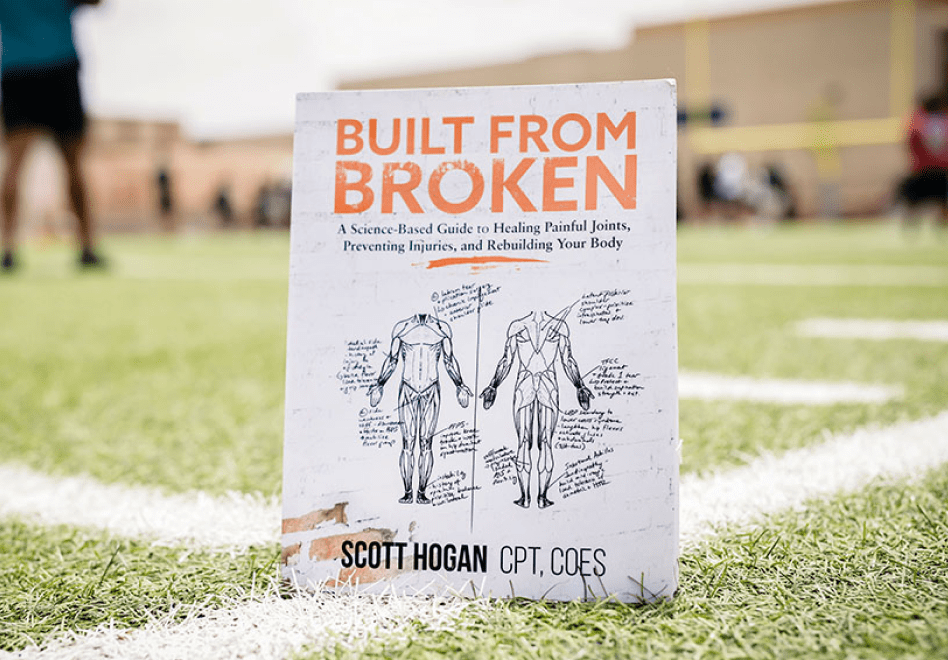
Be built (to last).
The right supplements can help you recover naturally and build a resilient body.

Supplement Quiz
Take this short quiz to discover the perfect supplements for your needs and goals.
About SaltWrap

Built from Broken
Get the best-selling book from SaltWrap founder, Scott Hogan, and start rebuilding today.
How a Ketogenic Diet May Help Injury Recovery
By Joe Zagami
Not since the Atkins Diet has any style of eating been more ubiquitous – or widely misunderstood – than the ketogenic diet.
“Keto” is easily the biggest buzzword to hit the mainstream diet and fitness space in the last decade. This is mainly because of its ability to help boost fat loss. Yet the ketogenic diet has many other purported benefits – including helping with injury recovery.
In this article, we’ll look at the evidence and show you how a ketogenic diet can help injury recovery. We’ll also tell you why carbs aren’t the enemy when it comes to healing injuries. We’ll even reveal the best ketogenic diet for athletes and active people.
But first, we need to set the record straight about what a ketogenic diet really is.
What Is a Ketogenic Diet?
There are a lot of misconceptions about ketogenic diets.
Worse yet, there are many plans out there claiming to be the one true “keto diet.” But the truth is that there is no single definitive keto diet. On top of that, there’s a lot of confusing – and conflicting – information out there.
That’s why it’s a good idea to start with a simple definition of a ketogenic (keto) diet that you could write on a cocktail napkin:
A ketogenic diet is a low-carbohydrate, high-fat diet designed to make the body burn fat for energy.
Why eat like this? Research shows there are many benefits to following a keto diet.
The big one is fat loss. Eating fat to burn fat may sound counterintuitive, but it works.
Carbohydrates are the body’s preferred fuel source. They’re easy to burn for energy. And they burn fast. With a keto diet, you set a strict limit on carbs. For the sake of simplicity, let’s say no more than 50 grams per day.
(For context, a medium banana has about 30 grams of carbs.)
By consistently limiting your carbohydrate intake, your body eventually makes a metabolic shift into a state of ketosis.
In a nutshell, this means that your body becomes very efficient at burning fat for energy. It also starts converting fat into ketones in the liver, which act as an “alternative fuel source” for the brain.1
Ok, quick recap time:
A ketogenic diet is a low-carb, high-fat diet. (Quick and dirty sample macros: 70% fats, 5% carbs, 25% protein.) The main benefit of a keto diet is that it puts the body into ketosis, which helps burn stored body fat.
Easy, right?
But there are benefits to a ketogenic diet beyond fat loss.
For instance, it can be a useful tool for maintaining healthy blood sugar levels. And that leads to one of the most intriguing potential benefits of a ketogenic diet – and one that would check an important box for the SaltWrap team:
Improved injury recovery.
How a Ketogenic Diet May Help Injury Recovery
Before we look at how a ketogenic diet may help with injury recovery, we need to make a quick but important disclaimer:
Carbohydrates are critical. They’re essential for everything from building muscle and fueling athletic activity to optimizing immune function and healing injuries.
(And they taste great.)
We’re not suggesting that lowering, limiting, or eliminating carb intake will help improve injury recovery.
Instead, we’re showing you an emerging – and interesting – body of research that points to a ketogenic diet having significant benefits for healing certain types of injuries.
More on that in a moment. But first, how could a ketogenic diet offer any edge when it comes to healing in general?
Several factors can affect the body’s ability to heal itself. Age is one. Nutrition is another. But one often overlooked factor is blood sugar.
Without drilling too deep, when blood sugar is out of balance, it can hinder the body’s natural healing processes. For instance, blood flow and new blood vessel creation – both critical for healing – can fall short.2
Well, we know that being in ketosis can have a positive effect on metabolic health. That includes maintaining healthy blood sugar levels. But that’s just part of the bigger picture.
A ketogenic diet has also been linked to decreased levels of inflammation. Animal studies have linked a ketogenic diet to reduced inflammation and even an improved lifespan.3
Other research has shown that ketones – the body's energy source when it’s in ketosis – decrease oxidative stress, increase antioxidants, and scavenge free radicals. These factors may also help with wound healing.
The research has been promising so far. But there’s one type of injury where the results have been particularly interesting:
Traumatic brain injury (TBI).
Being in ketosis produces ketones that act like an alternative energy source in place of carbs. But the exciting thing about ketones is their unique ability to cross the blood-brain barrier.
This is a big deal. Because in the case of TBIs, the brain can sometimes have problems processing glucose the way it did before.4
So, it doesn’t surprise us that experts want to study the effects of ketones and a ketogenic diet on healing TBIs in humans. It could have major implications for the general population, of course.
(For instance, what if following a ketogenic diet could help speed up the recovery process for car accident victims?)
But any developments in this area could be even more significant for athletes. Especially those involved in sports or activities where TBIs are common.
A recent pilot study at the University of Kansas looked at the ketogenic diet as a potential treatment for post-concussion syndrome. Concussions are the most common mild form of TBI.
Most patients’ symptoms often resolve in a month or so. But some can experience post-concussion syndrome, where symptoms can last for years.
This small “proof of concept study” found that following a ketogenic diet for eight weeks led to modest – but not statistically significant – improvements in post-concussion assessment scores.5
No, it’s not a slam dunk for the keto diet. But with human studies like these, where there’s smoke, there’s usually fire.
(Don’t be surprised to hear more updates about this area of study from SaltWrap in the future.)
But what does this mean for athletes and active people today?
Is a Ketogenic Diet Safe?
(And What Is the "Keto Flu?")
While there have been concerns about possible kidney risks with a long-term ketogenic diet (i.e., more than a year), for the most part, keto-style diets are well-tolerated by athletes and active people in the near- and short-term.6
But the key is to ease into a ketogenic diet gradually.
For example, let’s say your macros have resembled an old-school bodybuilding diet – something like 40% carbs, 40% protein, and 20% fat – for the last year. It would likely be a shock to your body to cannonball right into the deep end of a ketogenic diet that’s around 70% fat.
Plus, there’s something called the “keto flu.” It’s a set of symptoms that can present as the body adjusts to being in ketosis and burning ketones for energy. These can include fatigue, constipation, nausea, headaches, and (our least favorite side effect) bad workouts.
Some people breeze right through it. Others have a rough time. And some don’t experience any problems.
In any case, easing into (and out of) a ketogenic-style diet is likely the best approach for most athletes and active people when it comes to minimizing potential downsides – and maximizing benefits.
Putting It All Together
There’s a lot of information out there when it comes to the keto diet. But not all of it is super accurate… or super honest.
And despite what some internet gurus might try to tell you, there’s no single definitive “The Ketogenic Diet.” Still, if at least 50% of your daily calories are coming from fat, it’s safe to say you’re "going keto."
There are a few different ways to approach a ketogenic diet.
For athletes and anyone who wants to prioritize physical performance, we’d suggest trying a targeted and cyclical high-protein ketogenic diet.
That’s a mouthful. But in plain English, here's what it means:
Getting more calories from protein than a standard keto diet (think 30-35% instead of 20-25%)
Getting fewer calories from fat than a standard keto diet (think 60% instead of 70%)
Cycling higher-carb days (ex: training days) and higher-fat days (ex: rest days)
And targeting most of your carb intake immediately pre- and post-workout for maximum performance and recovery benefits – and without getting knocked too far out of ketosis.
Experience is the best teacher. No matter what exact numbers you land on, keep a close watch on your performance and how you feel. See if small tweaks can lead to significant improvements in either or both. (And make sure you’re tracking your macros instead of just eyeballing them.)
Look, a ketogenic is not a panacea for optimal health.
You might burn some extra body fat. But you won’t watch in awe as it melts away before your eyes.
It won’t magically heal your body from head to toe. But there are some exciting – and useful applications – for a ketogenic diet in wound healing. Especially in the context of TBIs, where there’s plenty of emerging science to be excited about.
If you're looking for help with injury recovery, you know that SaltWrap has you covered.
The best place to start is with Scott's Ultimate 5-Step Injury Recovery Guide. It lays out all the fundamental steps (and then some) for recovering from minor injuries.
By the time you're done with this free, in-depth resource, you'll know exactly when to seek medical attention, when to rest, and when (and how) to push through your injury to the other side. You can check it out HERE.
Of course, there are also proven natural supplements that can help the body heal itself. You can learn more about them in SaltWrap's Definitive Guide to Supplements for Injury Recovery.
In it, you'll find out why NSAIDs aren't your best choice for injury recovery. You'll also discover eight of the best (and most research-backed) natural supplements for injury recovery. Plus, you'll discover the five things you must avoid after injury for optimal natural healing.
Then again, maybe you're looking for a simple (but powerful) all-in-one natural solution for injury recovery.
That’s why we created Joint Clinic™.
We developed this science-backed (and multiple award-winning) multivitamin specifically for total joint recovery.
And it supplies your joints with the exact vitamins, minerals, recovery aids, and food-based antioxidants they need to optimize the recovery process.
If you want to optimize recovery and come back stronger, you’re going to love Joint Clinic.
Click the button below to learn more.
Founder: Scott Hogan

I created SaltWrap to bring together the most practical ideas in therapeutic sports nutrition, corrective exercise, and functional fitness — with the goal of keeping you (and myself) strong, mobile, and built to last.
I've worked as an A.C.E. Certified Personal Trainer, Orthopedic Exercise Specialist, and nutritional supplement formulator.
But more importantly — I've spent most of my life battling injuries, joint pain, and just being plain beat up. So I know what it's like to struggle toward fitness goals.
SaltWrap is here to push you through injuries, setbacks and perceived physical limitations. To a place beyond what you think you're capable of. Sign up here to stay in the loop.
Learn more about my best-selling injury prevention and recovery book, Built from Broken.








